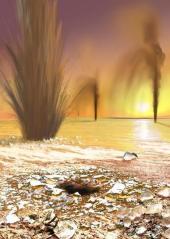Avalanche in the northern polar region of Mars. On the left the avalanche creates a 180-foot-high dust cloud after falling nearly 2,000 feet from the scarp edge. To the right, black markings on frozen dunes give indications of a partial defrost. Photographed from an altitude of about 200 miles, the clarity of this view gives a clear indication of the spacecraft telescopeâs power. Mars Reconnaissance Orbiter, Jan. 27, 2010

Artist rendering by Ron Miller/JPL/Arizona State University
The rule for space aesthetics has always been clear: First comes the science, then comes the art. You can’t take the most distant cosmic photographs ever captured unless you build and launch the Hubble Space telescope first. You can’t capture close-up shots of Neptune’s aquatic blue or Jupiter’s spin-painted atmosphere or Saturn’s braided rings until you get the Voyager spacecraft out to their neighborhood.
(Photos: Window on Infinity: Pictures from Space)
Now that rule is being proven again with sensational images making the rounds on the Web — and soon to be published in the new book Planetfall, by Michael Benson — that provide a cool and new and faintly eerie look at Mars. Benson is not a NASA engineer, much less an astronaut. What he is however is a photographer and media artist, one with an unusually sharp eye for images from the deep elsewhere that can dazzle terrestrial sensibilities like ours.
(More: Martian Blizzard: It’s Snowing on the Red Planet)
The pictures doing the dazzling today were shot by the Mars Reconnaissance Orbiter (MRO)in 2010 and show the predictable — if beautiful — rusty dunes of the Martian surface, sculpted like snowdrifts from the planet’s tenuous but persistent wind. The scene is broken up, however, buy strange, black, spidery blemishes scattered randomly about. From orbit they look tiny, but on the ground they’d be huge — surely larger than a football field. It’s partly their very ugliness that makes them eye-catching and partly the mystery of what causes them. Actually, however, that last part is likely no mystery at all — and the source of the features is one more indication of how complex a planet Mars is turning out to be.
(More: Compelling New Evidence For Flowing Water on Mars)
While Mars can sometimes be an almost temperate place — at high noon in midsummer on the Martian equator, temperatures can reach or exceed 70º F (20º C) — at other times it can fall as low as -225º F (-153º C). This can have a dramatic effect on Mars’s two most important volatile substances: water and carbon dioxide. Last year, MRO images revealed seasonal markings on Martian slopes, with long, dark streaks appearing in the spring and summer and vanishing in the winter. The streaks emerge and retreat at cycles in the Martian year consistent with the freezing and thawing points of water, suggesting that subsurface ice deposits are intermittently melting and running and then retracting back into the soil as the thermometer falls. Said mission scientist Mike Myer at the time the finding was announced:
“Since the MRO arrived at Mars our overarching theme has been ‘follow the water.’ Now we may be catching Mars in the act. We have found repeated and predictable evidence of water flowing on the surface.”
The spidery splatters in the current images show up seasonally too, but they’re too big to be slowly flowing water and their appearance doesn’t always coincide with temperatures within water’s freeze-thaw cycle. Instead, investigators theorized as long ago as 2006, in a paper in Nature, that they could be carbon dioxide, which is present on Mars in much greater abundance than water and would not just seep to the surface, but erupt out of it, as the CO2 went suddenly from solid to gas. As the researchers wrote in the Nature paper:
We propose that the seasonal ice cap forms an impermeable, translucent slab of CO2 ice that sublimates from the base, building up high-pressure gas beneath the slab. This gas levitates the ice, which eventually ruptures, producing high-velocity CO2 vents that erupt sand-sized grains in jets to form the spots and erode the channels. These processes are unlike any observed on Earth.
And how. With MRO still orbiting Mars and two active rovers on the surface, the data stream from the Red Planet will continue. It doesn’t take the likes of Benson to make those new discoveries. But we rely on him and other media artists all the same to help us see — and appreciate — the science like we never otherwise would.
(Photos: Snapshots of the Heavens: Amazing Astronomy Images)
(More: Martian Find: Evidence of an Ancient, Rushing Stream)

